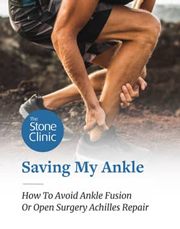The High Ankle Sprain: What’s New in Soft-Tissue Injuries
Lebron James suffered a high ankle sprain and the web went crazy searching for definitions. The real question is: What is new in treating these injuries? And what is coming next?

The high ankle sprain is the tearing of the ligamentous tissue holding the fibula to the tibia (the two long bones in the lower leg). With a strong rotational force— which can happen when a tall muscular athlete falls onto another tall muscular athlete and rotates the ankle during the fall—something has to give. Either the bones break or the ligaments holding them together tear.
The problem is that, with every step, the ankle joint normally widens slightly to permit the talus (the bone at the arch of the foot) to tilt up. If it didn’t, you would walk with a stiff ankle. To widen, the fibula must rotate slightly. Therefore the ligaments holding it to the tibia are stretching and relaxing. When those ligaments are torn during a high ankle sprain injury, the ankle becomes unstable as the fibula widens too much. The traditional treatment is a brace, rest, and ice—but the healing time is unpredictable and often measured in months.
The challenges are the biology and biomechanics of this injury. A torn ligament in the ankle is being constantly stretched as the athlete walks. Not walking leads quickly to muscle disuse atrophy. The bleeding from the torn tissues forms a small clot around the damaged area, which must be remodeled into healing tissue. Ligaments are made of collagen—and cells from the clot and the tissue extrude collagen fibers. But it can take up to a year to form new fibers and weave them into a strong construct. The athlete wants to play now.
Current advances in treatment are focused on how to accelerate the remodeling of the clot, hasten the arrival of new cells, then stimulate the formation and maturation of new collagen. Early in the injury, the focus is on clearing out damaged tissue. Alternating heat and cold circulate blood and fluid in and out of the leg. Ice baths and heating techniques, including laser light and ultrasound tissue heating, are options.
At the mid-stage, new collagen production is required. Simple, deep massage mobilizes fluid from swollen tissues while stimulating the mechanical receptors on the surface of cells to release new collagen. While some techniques of massage are thousands of years old, new forms of tissue vibration include advances in electric massagers, ultrasound, and magnetic field tissue activation. While these may not traditionally be thought of as massage, they are all techniques for vibrating tissue and accelerating healing. And these techniques—as we learn which frequencies induce specific cellular responses—are being fine-tuned.
At the local level, growth factors from platelets (PRP) and other sources are now being used to bathe the damaged tissue. These factors have a combined anti-inflammatory, antifibrotic (scarring), anabolic (cellular stimulation), and antimicrobial effect. They augment the body’s own vascular response to bring the products of self-repair cells to the damage.
Almost all sports injuries at the pro level are now being treated with these injections. Meanwhile, medical science is advancing to select which injection is right for which injury—since clearing an injured ligament differs from treating damaged cartilage or an arthritic joint.
Collagen maturation is the final part of the healing process. The injection of PRP and growth-factor-rich fluids introduce cytokines, which activate our own stem cells to produce progenitor cells that direct the healing response. We are coming to understand that stem cells and their self-repair derivative cells are often the directors of the healing response. They convert local quiescent cells into active ones, optimizing the biochemical environments to set the stage for tissue healing. (As the body has billions of stem cells, injecting cytokines to recruit them makes more sense than injecting stem cells from an outside source.)
We know that the mind also plays a critical role in tissue healing. An optimistic outlook, while willing the tissue to heal, actually makes a difference. This is most often achieved by hard sweat workouts while protecting the injury. These can include resting the leg while on a stationary bike, lifting weights while standing on one leg, core workouts, Pilates, and many other forms of clever exercises. Such training raises the heart rate, increases blood flow to the injury, and elevates endorphins, pheromones, testosterone, and adrenalin, all of which accelerate healing and improve the outlook.
Combining the therapies of today is the state-of-the-art as we know it. Lebron will likely spend several hours a day using all of these tools. His team and doctor will bathe the tissue with the injections, massage the area with every technique, and boost his physique with novel training exercises. Healing is a team approach—and, fortunately, you don’t have to be a pro athlete to access this team.

